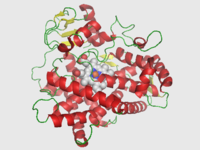
Photo from wikipedia
BACKGROUND The metabolic action of CYP2D6 remains a crucial factor influencing the therapeutic outcomes for many drug molecules while others are either only slightly affected or not affected altogether. OBJECTIVE… Click to show full abstract
BACKGROUND The metabolic action of CYP2D6 remains a crucial factor influencing the therapeutic outcomes for many drug molecules while others are either only slightly affected or not affected altogether. OBJECTIVE This study seeks to understand, atomistic resolution, the structural and physicochemical factors influencing CYP2D6 metabolic discrimination. METHOD Explicit solvent molecular dynamics simulations in GROMACS were employed to probe the conformational dynamics of CYP2D6 following which the most populated structures were employed for ligand interaction docking studies with AutoDock Vina using selected CYP2D6 drug substrates. RESULTS Using atomistic treatment at the molecular mechanics level and multiple CYP2D6 conformations for docking, two primary ligand binding subsites (subsites A and B) were identified within an otherwise extensive ligand recognition site. The studied drug molecules were found to display distinct preference for either of the two subsites. Correlation and center-of-mass distribution analysis showed subsite binding preference to depend significantly on CYP2D6 conformation, as well as molecular properties such as molecular size and number of hydrogen bond donor present in the drug molecule. CONCLUSION CYP2D6 binding subsite A was found to be relatively selective for small molecular weight with higher polarity compared with subsite B which tends to favor larger molecular weight and relatively hydrophobic molecules such as tamoxifen and imipramine. Our simulations further suggest that the ability of the CYP2D6 binding site residues to sample different conformations may partly account for its ability to metabolize diverse drug classes.
Journal Title: Current computer-aided drug design
Year Published: 2017
Link to full text (if available)
Share on Social Media: Sign Up to like & get
recommendations!